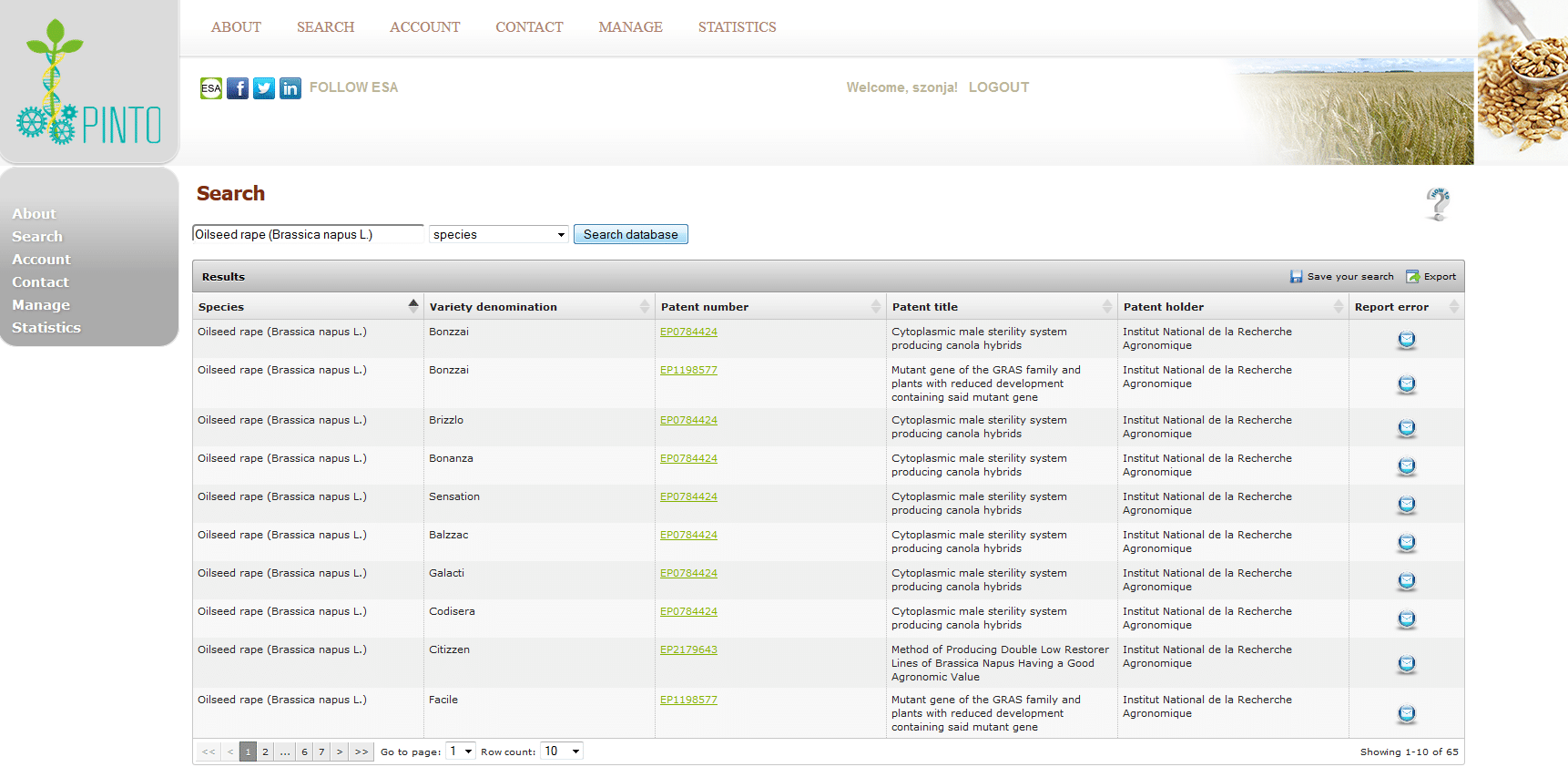PINTO database offers breeders critical information on protected varieties.
For breeders and their bosses it’s always a tough question: how do we know which varieties we can freely use in our breeding programs? This issue has been facing breeders for the past couple of decades but has now become urgent as seed companies, large and small, have started patenting plant traits. Which in turn, extends to the varieties with these traits. Wouldn’t it be nice if we could all look in one place and get the information we need?
There are several databases that try to fill this gap in the industry. One such database is PINTO (Patent Information and Transparency On-line) built by the European Seed Association (ESA) in 2013. ESA created the PINTO database in an attempt to provide a tool for breeders to get more clarity and information on the patent status of plant varieties, explains Szonja Csörgö, director IP and legal affairs of ESA.
There are a number of public databases providing information on patent applications and granted patents but the novelty of PINTO is that it provides information on whether a specific plant variety is covered by the scope of one or several patents. “Public patent databases normally provide information on the claims of a patent application or granted patent but from reading a claim it is almost impossible to know which varieties — that are available on the market — would be falling within its scope. This is the gap that PINTO aims to fill in,“ says Csörgö.
In Europe, new plant varieties can be protected by the sui generis intellectual property system of plant breeders’ rights (PBR) based on the International Union for the Protection of New Varieties of Plants (UPOV). Tailored to the specificities and needs of plant breeding, such protection guarantees the continuous flow of improved plant varieties by safeguarding access to genetic variability through the so-called breeder’s exemption. Besides PBR, patents also play an increasingly important role in the European seed and plant-breeding sector. Under European patent law, plant varieties as well as essential biological processes for the production of plants are excluded from patentability. But in practice, as a result of the specific nature of plant-related patents, plant varieties may fall under the scope of certain patents. Under patent law, however, there is no general breeder’s exemption, therefore the use for further breeding of a plant variety covered by the scope of a patent and the commercialisation of the newly-bred plant variety is always subject to conditions.
In order to be able to define their ‘freedom to operate’ when starting their breeding programs, breeders need to know whether the plant variety they intend to use falls under the scope of a patent application or a granted patent. As already mentioned, there are a number of public patent databases providing important information on patents, but this specific element cannot be found in those databases. Therefore, PINTO has been created with the primary goal of allowing breeders to make a more informed choice when deciding on the varieties to be used in a breeding program.
Currently, PINTO includes more than 1 000 entries, belonging to 15 different crop types, which means that it provides information for these 1 000 plant varieties regarding their patent status. The number of patents that are currently included in PINTO is 23, but some of the varieties that are included are covered by the scope of two or more patents at the same time. The information from PINTO can be retrieved in various ways depending on the search criteria a user is selecting. One can look for a specific variety by denomination, or check the coverage of a patent by selecting a specific patent number, or you can get an overview of the patent situation in a specific crop if only the crop is selected in the search criteria. Further, combined searches are also possible to make the research more targeted and reduce the number of hits in the end.
With regards to its users, it has to be underlined that PINTO is a public database aimed primarily at breeders but available free of charge to anybody who wishes to use it. Therefore, users of PINTO are individual persons who — in the large majority of cases — belong to the community of plant breeders and thus are linked to specific companies, but there are also a number of users who are not necessarily breeders. In total, PINTO currently has close to 400 registered users from all over the world.

you to search for several aspects of a variety or patent.
Completing PINTO
The database itself performs well and generates the requested information quickly. Information included in the PINTO database is updated every six months. This means that since the creation of PINTO there have been two general updates, both resulting in the expansion of the coverage of PINTO with more varieties and patents being added. Nevertheless, a continuous challenge remains: its completeness.
PINTO is constructed on the basis of information received from companies developing and marketing varieties under the scope of patents. Companies contribute to PINTO on a voluntary basis and ESA is continuously working on reaching out to as many companies as possible in order to make PINTO as complete as possible. Despite all these efforts the exercise is still far from being finalised, and a lot of work still needs to be done on coverage. As such, it has to be accepted that PINTO, due to its voluntary nature, will always remain incomplete to some extent and thus complementary tools are necessary for breeders to get a full picture on status of varieties.
Francois Meienberg from the non-government organisation Berne Declaration agrees. He mentions that the PINTO database could be a helpful tool to increase transparency regarding varieties covered by patent claims; not only for breeders, but also for farmers, consumers, NGOs or civil servants. For this to happen, the database needs to be more reliable with further improvements made.
He feels the information needs to be more detailed in regard to which companies or other breeding institutions participate, and especially which do not participate. It has to be clear what happens if a company which is not participating in the database sells varieties under a patent license from another company or when the company is out-licensing its own patents.
“The goal should be a full transparency for each and every variety on the market if it is covered by patent claims or not.”
“The goal should be a full transparency for each and every variety on the market if it is covered by patent claims or not. Probably, such a full coverage will only be possible if the database is managed by a governmental agency and when there is a legal basis to make it mandatory to provide the requested information. When we get rid of patents on seeds, the whole information gathering and bureaucracy will not be needed anymore,” according to Meienberg.
Others can attest to PINTO needing more work. Another disadvantage is that the PINTO database only includes varieties that are available in countries that belong to the European Economic Area (EEA), which is comprised of all of the EU and members of the European Free Trade Association (except for Switzerland). Finally, the PINTO database is limited to European patents and applications only.
“As most breeding companies are active all over the world, PINTO might be regarded as incomplete,” says Arend Streng, patent specialist at Rijk Zwaan in The Netherlands. He mentions that, especially for breeders, PINTO is a practical tool to see whether a certain variety is protected by a patent or application. “The database provides information on the commercial embodiment of a patent and is by my knowledge the first publicly available database doing so. This information helps breeders to see which varieties are not freely available for further innovation.”
Still, Streng does find PINTO highly useful.
“The PINTO database is a helpful tool to relate patent [applications] to plant varieties. Personally, I use the database about once every month. The database has an efficient structure and interface that allows you to search for several aspects of a variety or a patent [application]. The fact that it gives a direct link to a patent in the database of the European Patent Office (EPO) is useful. Also, users are able to register themselves in order to customise their searches.”
Csörgö confirms that the geographical scope of PINTO is currently limited to Europe (EEA), meaning that only varieties registered or marketed in the EEA are to be included in it. Once the completeness of the database is significantly improved on the European level, discussions will also continue on how to expand the scope of PINTO to other parts of the world.













